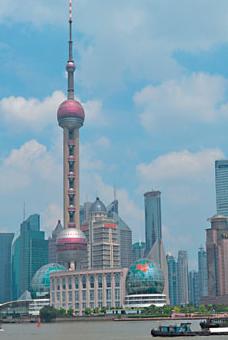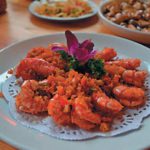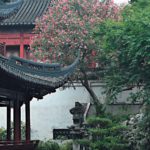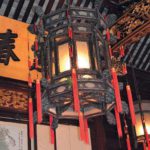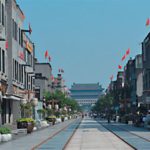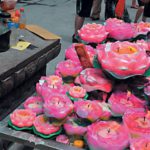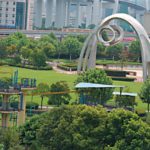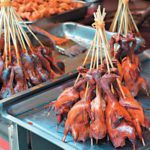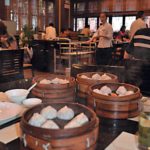A journey to China confirms that there is no limit to the gastronomic experiences that await you, says reader Gaylyn Wingate-Pearse
Chinese people greet each other with the phrase “Ni chi fan le ma?”, which means “Have you eaten yet?”, indicating their prime concern for how full your belly is. From the thousand different Cantonese dim sum in the south, to Shanghai’s hairy crab, the fiery feasts and Kung Pao chicken of Sichuan in the west and the Peking duck and wheat noodles of the north, food is a divine pleasure to the people of the Middle Kingdom.
I’ve always wanted to visit this vast country and my brother’s inclusion in the South African men’s water polo team taking part in the FINA World Aquatics Championships in Shanghai last year was the perfect opportunity. Our first stop was Hong Kong, a cosmopolitan metropolis with an intoxicating mix of Eastern and Western culture, and one of the world’s greatest food capitals. According to the Hong Kong Tourism Board, the city has about 11 000 restaurants and it would take 28 years of eating out every night to experience all of them.
Hong Kong, meaning fragrant harbour, is one of the most densely populated places on the planet (just over seven million people call it home) but its bustling streets are easy to navigate. And it is down the little lanes and alleyways where you encounter dining treasures that have locals queuing for blocks – one of them being the city’s staple, dim sum.
They can be enjoyed at any time in this 24-hour city but they are most commonly consumed as a midmorning meal. Maxim’s Palace City Hall in Wan Chai is the place to go – just choose your dim sum (translated as “to dot the heart”) from the trolleys as they trundle past your table in this humungous dining hall. For a real taste of the good life, we visited the Peninsula Hong Kong, hailed as one of the finest luxury hotels in the world. Afternoon tea is possibly the best colonial legacy in Hong Kong and for around HK$300 (about R300), you can enjoy dainty cucumber sandwiches, plump scones with Devonshire clotted cream and melt-in-your-mouth pastries.
No visit to Hong Kong is complete without two trips – one across Victoria Harbour aboard one of the famous Star Ferries and a second on the Peak Tram up Victoria Peak. The Star Ferry has been crossing the waters between Hong Kong Island and Kowloon since 1898 and every day more than 70 000 passengers take this five-minute journey which costs HK$1.
We boarded the Peak Tram, which began operations in 1888, for its eightminute climb up Victoria Peak, where we were rewarded with fantastic views from Hong Kong Island’s tallest hill. With street names like Salisbury, Queen and Gloucester, shops such as Tiffany & Co, Burberry and Crabtree & Evelyn, restaurants such as TGI Friday’s and even one called Yorkshire Pudding, it’s not surprising that a huge percentage of the island population speaks English.
But if for a second you forget you’re in Asia while tucking into your fish and chips on Nathan Road, just walk up the busy shopping street, also known as the Golden Mile (because of the plethora of electronic shops) to the Mong Kok markets where you’ll encounter eye-popping sights and smells that more than tickle your nose. Earlier that day, while waiting outside our hotel for a taxi, the concierge said that the Chinese often joke that they “will eat anything with legs except a table, and anything that flies except a kite”. Only while walking through the markets did I realise how close to the truth that was.
The two-hour flight from Hong Kong to Shanghai was the shortest ‘international’ flight I’ve been on and the two cities are equally cosmopolitan, modern and bustling. As we were in Shanghai for nearly two weeks, I found an affordable spot down a little lane in the French Concession where, for 600 yuan renminbi (about R720) a night, we had two bedrooms, a kitchen, lounge, dining room and bathroom. We also had a washing machine and tumble dryer and mimicked our Chinese neighbours by hanging our laundry on bamboo poles balancing on the walls surrounding our little garden.
Only after an expensive trip to the grocery store (where a packet of salt and vinegar crisps cost as much as three sacks of potatoes), did we find the markets frequented by the locals. The guide books (and locals) seem to think all foreigners want to buy only imported goods. And if we did feel like Western snacks, the local convenience store Alldays sold Numb & Spicy Hot Pot or Seaweed flavour Pringles for just a couple of yuan.
Nearly 1 300km from my first introduction to Asian markets, the stalls in the Shanghai Food Market on the corner of Taiyuan and Jianguo roads were a true assault on the senses. While bullfrogs croaked, eels wriggled and chickens squawked, the stews of intestines and slabs of snake meat had aromas that left a lot to be desired. This particular market is famous for its duck-blood soup and thousandyear- old eggs. The soup, a Shanghai favourite, contains solidified cubes of blood as its main ingredient and has a unique pairing of sweet and sour flavours balanced against a rich broth.
Thousand-year-old eggs are duck, chicken or quail eggs preserved in a mixture of clay, ash, salt, lime and rice straw for several months. After the process is complete, the yolk becomes a dark green, cream-like substance with a strong odour of sulphur and ammonia, while the white becomes a dark brown, transparent jelly with little flavour.
The market also has a poultry slaughter house where you can choose from the rows of cages holding live chickens, geese, roosters, ducks or pigeons. Within five minutes, you’re walking away with your selection neatly chopped up in a plastic bag. But not everything in the market leaves your tummy turning. The colours, shapes, textures and variety of the fresh fruit and vegetables are mind boggling. From the exotic dragon fruit, jujubes and mangosteen to the voluptuous melons, marrows and peaches, you can be confident that anything fresher is still growing. And you can understand why the fruit and vegetable market is the largest sector of the retail food market in China.
One fruit that definitely caught my nose was the durian, widely known and revered in southeast Asia as the ‘king of fruits’. Shaped like a rugby ball (and about as big), it has a tough, spiky skin with edible yellow flesh that has an unusual flavour and intense odour. Descriptions of its taste and smell include sewage, old gym socks and turpentine but it has also been called so exquisite that a European explorer of the 1700s claimed it was worth the journey to experience it. Nevertheless, this stinky fruit has been banned from certain hotels and public transport in Asia.
The fascination with Shanghai lies in the city effortlessly mixing modern architecture with traditional charm. It is an eclectic mix of hole-in-the-wall eateries alongside five-star restaurants serving top-notch international fare. It is a veritable feast with something for everyone (not an easy task with a population of 23 million). Near The Bund, a waterfront area along the western bank of the Huangpu River facing Pudong, we visited a restaurant in the centre of the Old City that was both a hole-in thewall and fine-dining establishment! A culinary icon and stalwart in Shanghai for more than a century, The Nanxiang Steamed Bun Restaurant is situated at Yuyuan Garden, one of the most lavish and finest Chinese gardens in the region, first established in 1559.
You can either join the takeaway queue which worms its way from a serving hatch down the side of the building, share one of the tables on the first floor or dine in style on the luxurious top floor. The price goes up and the wait goes down as you ascend the three floors of the restaurant, but the wait on the top floor is still around 15 minutes if you arrive after 10am.
The wait for the xiao long bao (soup dumplings) is worth it though. These scrumptious little pouches are more than your normal flour-dough wrappers filled with pork, crab or roe – the delicate dumpling is also filled with a rich, warming broth. We also tried their award-winning offering of a king-size crab roe steamed bun where you sip the filling and broth from a giant dumpling tucked snugly into a bamboo basket.
We took the new superfast train from Shanghai to Beijing and shot across the vast country, travelling at 350km per hour and reaching our destination in just five hours (a little under half the time it normally takes for the 1 320km journey). The difference between Hong Kong and Shanghai is as vast as the difference between Shanghai and Beijing, and you can literally feel the politics and history in the air.
On our way to the Great Wall, we were even told to be a little careful of what we said out loud when visiting Tiananmen Square and the Forbidden City because of the plain-clothes policemen dotted around the city’s magnificent attractions. While Beijing might not be the most foreign-belly-friendly city in China, it is the place to be if you’re after Peking roast duck. We visited the largest duck restaurant in the world, Quanjude, a seven-storey restaurant on Hepingmen Avenue, a few blocks from the Forbidden City.
We knew to come early as they don’t take bookings and if you arrive after 6pm, you can wait for up to three hours. It has a floor space of 15 000 square metres divided into 41 dining halls, including one which can serve 600 customers simultaneously. Filled to capacity, Quanjude can serve as many as 5 000 meals a day. The preparation of the dish requires a series of complicated steps, which include inflating the unbroken skin like a balloon so that it roasts just right, and is so soft and crisp that it melts in your mouth. Slicing the meat from the duck carcass is an art in itself. A skilled chef can cut 100 to 120 slices in four to five minutes.
The next night, we visited Beijing’s Donghuamen Night Market. The longest street food market in the world, it is a must-do culinary experience, although Gaylyn Wingate-Pearse Donghuamen Night Market the length of your visit does depend on the strength of your stomach. You can order anything from deepfried starfish, seahorse skewers and scorpion soup to sea urchin, snake and baby shark. We also found ‘herb jelly’ (strawberry jelly with two rosa tomatoes) and a ‘fried enema’ (we didn’t order one though).
There’s no doubt that China is full of surprises. It’s smoggy and congested, chaotic and unapologetic. But it is also breathtakingly beautiful and overwhelming majestic. It is a country of extremes – so rich in history and sophistication that certain traditions and etiquette must be followed, yet spitting on the pavement or burping loudly doesn’t raise an eyebrow. But the fullness of your belly trumps it all. Have you eaten yet?

